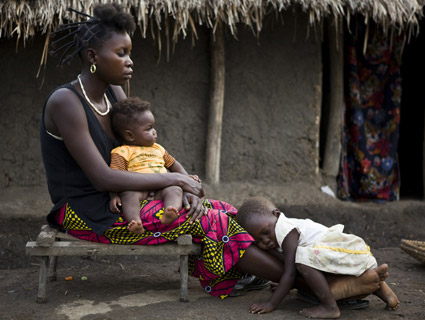Since President Obama’s announcement on Friday that he will send 100 soldiers to Uganda to help fight the Lord’s Resistance Army, a rebel group that’s been responsible for killing thousands of civilians over more than two decades, most of the media coverage has focused on whether American troops will actually be engaging in combat and whether the move is meant to pay back Uganda for keeping troops in Somalia.
But UN Dispatch‘s Mark L . Goldberg points out some potentially important context about the conflict. Like what happened to civilians when the Ugandan Army took on the LRA in 2009:
About half the 100,000 people displaced amid a wave of atrocities in north-eastern Democratic Republic of Congo (DRC), where the Ugandan army is leading an operation against Lord’s Resistance Army (LRA) rebels, have no access to humanitarian assistance, according to the UN.
“We estimate that half the displaced are beyond reach. There are no roads or airstrips. In some cases they are close to where the fighting is,” Idrissa Conteh, a spokesman for the UN Office for the Coordination of Humanitarian Affairs (OCHA), told IRIN in the north-eastern DRC town of Bunia.
In an area where clashes can leave the most vulnerable populations even more vulnerable, there’s no telling what effect this new phase in the war against Kony might have on innocent bystanders.
And, from Ugandan journalist Rosebell Kagumire (h/t Laura Seay), another important piece of the deployment picture: What do Ugandans think?
Many Ugandans, through various social networks, have expressed skepticism over the 100 combat troops the US deployed to Uganda to help stamp out the rebels of Lord’s Resistance Army currently operating in the Democratic Republic of Congo (DRC), Central African Republic (CAR) and parts of western South Sudan.
They think what they are actually here to do is secure for their country Uganda’s newly found oil.
That’s probably based more on skepticism about the United States’ motivation to send troops to other countries than actual fact—Uganda and the United States are already plenty friendly enough to strike oil deals. Read Kagumire’s analysis of why Ugandans may need the American support anyhow—and why the Americans will need to wrap up their mission quickly. At least the International Criminal Court, which issued arrest warrants for LRA leader Joseph Kony and four of his other commanders six years ago, is probably happy to have some additional troops on the case. All of the LRA leaders remain at large except for one. And that’s because he died.
















